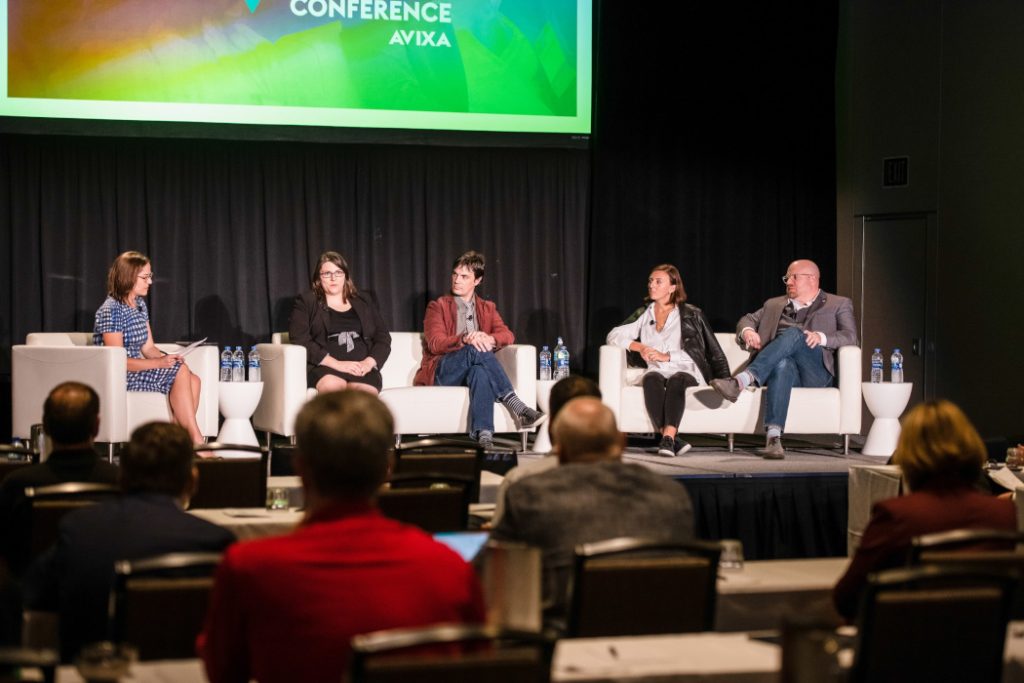Since its inception in 2013, AVIXA’s AV Executive Conference (AVEC) has gathered industry leaders to focus on their businesses. Through thought leadership, workshops, networking and even homework, attendees have had a chance to consider new ways of excelling in commercial AV.
This year, with the voice of the end user gaining influence, AVEC had a different feel. We invited decisionmakers, influencers and AV customers to give firsthand accounts of how they approach technology designs to maximize desired outcomes. With a pair of concurrent tracks going on, I jumped around to glean insights from speakers in the corporate, higher-education and event-production markets. I wanted to share some of those insights here.
My day of breakout sessions began with a panel discussion centered on the corporate market for AV solutions, deemed the lifeblood of the commercial AV industry. Corporate AV accounts for $40 billion of commercial AV revenue globally this year, according to AVIXA’s Industry Outlook and Trends Analysis. What are leaders in the corporate space discovering about the market?
Kay Sargent, Senior Principal and Director of WorkPlace for global architecture firm HOK, said her company’s clients understand change is not something that happens occasionally—it’s a constant people are living with every day. Because of the relentlessness of change, it’s important to create flexible environments and workspaces.
HOK’s clients are more aware than ever that their people are their most valuable resource. With the focus on user experience, Sargent said HOK considers how a space serves the people, including how it affects their well-being. “As design professionals in our industry, if we do anything to negatively impact the ability of people to be successful, like squeezing the real estate too much or not giving them the tools or IT that they need, then we could actually cost that company money, not save them money,” Sargent said.
Before making decisions about workplace design, companies have to understand what they are. If the type of work requires minimizing distractions, then open-concept workspaces wouldn’t work well. Sargent advised attendees to take an activity-based approach when designing workspaces.
Companies also have to take the mobile workforce into account. It’s important to leverage desktop video to help create personal interactions and build relationships, Katherine Williams, Senior VP for global commercial real estate company JLL, shared. Live annotation is another AV solution that she said helps with mobility.
Next on my agenda was a session with leaders in higher education, who discussed the role technology plays in learning spaces. Barbara Brandt, Manager of Classroom Technologies at Emory University, said higher education is seizing on a lot of practices from the corporate world. For instance, schools are increasingly embracing software codec videoconferencing due to lower cost and flexibility.
Bryan Lewis, Assistant Dean for Technology and Operations, University of Virginia McIntire School of Commerce, said that the university is ripping out hardware codecs left and right and creating Zoom videoconferencing rooms. The university is spending about the same amount of money as before; however, the classrooms now have more capabilities, due to the availability of solutions that are more sophisticated but less expensive.
The University of Virginia is also utilizing videoconferencing as more distance learning is incorporated, thereby bringing a lot of AV components into the classroom, Lewis shared. Distance learning requires displays in the front and back of the classroom, thereby enabling the instructor and students to interact with a distance-based audience. Careful consideration is also taken regarding camera positions and audio equipment for far-side instructors so that the experience appears seamless to all parties.
The rise in adult learners was an interesting topic broached during this panel. Lewis said that only about 20 percent of the University of Virginia’s students are “college age” nowadays. “We’re designing more spaces for older eyes and older ears,” he explained. “So, the old rules of thumb in terms of how big the displays were and how much real estate we needed are kind of out the window.”
The last breakout session I attended was a gathering of event producers, who discussed how technology can make experiences more personal and interactive. Digital art gallery ARTECHOUSE recently implemented augmented reality (AR) as a way for people to use their phones to discover new art pieces. People hunted for digital art installations around Washington DC—from the Smithsonian to the Washington Memorial—only viewable through an AR mobile app. Tati Pastukhova, Managing Director of ARTECHOUSE, said the gallery uses technology applications like this to encourage participation and facilitate a communal experience.
Feld Entertainment, which produces shows like “Disney on Ice” and “Marvel Universe Live!,” is often tasked with keeping both children and their parents entertained for 90 minutes. Brad Berridge, Director of Sound Operations for Feld, said the company employs technology to make live shows more immersive. For instance, it has audience members wear a simple Bluetooth wristband that allows them to participate in the storyline and help the superheroes save the day.
The session’s event producers favored AR over virtual reality (VR) technology, stating that VR can isolate you from reality. And, although certain technologies can bring the “awe factor,” you must always consider your audience. For example, four-year-old kids don’t want to wear VR glasses, Berridge said.
A unifying message I took away from the diverse range of speakers at AVEC is this: Focus on the user experience. How do you improve the way that a team collaborates in an office? How can we learn from people thousands of miles away? How do you make a live show unforgettable? By understanding your goals and your audience, and by finding the perfect blend of technology to render remarkable experiences.
AVEC returns November 5 to 7, 2019, in New Orleans LA. Learn more at www.avexecutiveconference.com.
